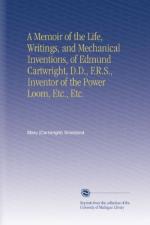|
This section contains 385 words (approx. 2 pages at 300 words per page) |
World of Invention on Edmund Cartwright
The English textile industry was revolutionized by Richard Arkwright 's water frame spinning machine. Using the water frame, wool and cotton yarn could be spun faster and more efficiently than with a spinning wheel or spinning jenny--all without the need for manual labor. However, the new spinning machine created a new problem, for hand looms could not match the pace of the water frame, causing a surplus of yarn to accrue. This problem was partially solved by the invention of Edmund Cartwright 's mechanical loom.
Cartwright was born in Nottingham, England. In 1784 Cartwright took a holiday to Matlock, not far from Arkwright's water frame cotton mills. It is said that, while there, he engaged Arkwright in a conversation as to the difficulty of creating a powered weaving machine. Inspired, Cartwright began the construction of just such a machine the moment he returned home.
Cartwright's first loom was clumsy and ineffective--primarily due to the fact that he had built it without first actually seeing a hand loom. Although the device was barely functional, Cartwright took out a patent and began to make improvements. Employing several local manufacturers as advisors he constructed two more prototypes, and by 1790 had completed a mechanical loom able to weave wide cloth, such as calico.
Cartwright established a factory for his looms in 1786. While his earlier models did not attract much attention, the power loom completed in 179O worried the local weavers, who feared (correctly) the machine would replace them. Thus, in 1791 the factory burned down under mysterious circumstances, and Cartwright found himself in debt. He attempted to offset his losses by inventing an ingenious wool-combing machine; however, this, too, was opposed by local workers, and Cartwright collected little from its patent. In 1793 he was forced by his financial situation to sell his factory and patents.
He soon moved to London, where he applied his inventive abilities toward agriculture. He invented a reaper, and won prizes from the Board of Agriculture for his essays on husbandry and manure use. He also acquired the patent for a rope making machine and for an alcohol fueled engine. When the patent for his mechanical loom expired in 1804, Cartwright petitioned the House of Commons for restitution, and was awarded a sum of 10,000 pounds. He continued to develop new agricultural devices until his death in 1823.
|
This section contains 385 words (approx. 2 pages at 300 words per page) |


